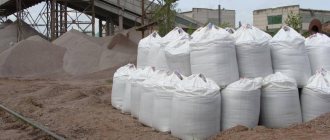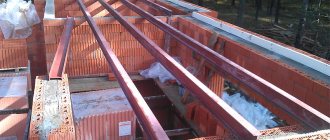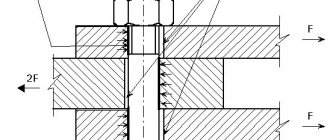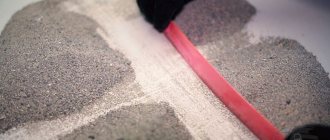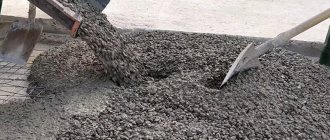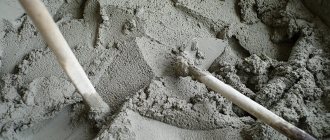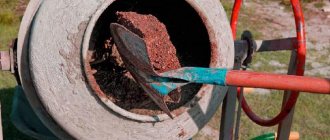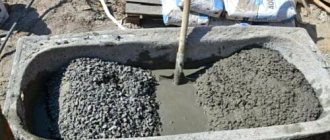- 1 Purpose of PGS
- 2 Types, mixture structure
- 3 Features of mass selection
- 4 Compaction degree
- 5 Concrete preparation process
- 6 Necessary recommendations
- 7 Conclusion
The high pace of construction, the accelerated development of residential areas and office buildings makes us think about the quality characteristics of concrete. It is impossible to create a strong, strong foundation without concrete mortar. Concrete is the main connecting and structural material in construction. The quality of concrete directly affects the strength and service life of structures. The solution can be prepared from sand and gravel mixtures, paying attention to the source of origin and observing the required ratio of components.
Purpose of PGS
Sand-gravel mixture, or otherwise ASG, consists of sand and gravel. The composition is prepared in two ways:
- natural;
- artificial.
The resulting mixture is in great demand and is used in industrial, road, and housing construction:
- for asphalt concrete pavements;
- for the manufacture of monolithic, reinforced concrete structures;
- as a drainage layer of the road surface;
- landscape leveling.
Return to contents
Types, mixture structure
Gravel in the mixture should be up to 75% by weight.
The proportional content of sand and gravel in the mixture is the main criterion for gravel mass. Gravel should not be more than 75% of the total mass. Great importance is paid to the size of components, and they are also checked for compliance with standards. Based on the proportional content of components, two types of sand and gravel are distinguished:
- Natural (pgs). The ratio of gravel as a percentage relative to the total mass is no less than 10 and no more than 95 - 1/5 of the total composition. The classic composition is not subjected to additional processing. The gravel mass is extracted from a quarry and immediately shipped to the buyer. Basically, the gravel content is 10-20% of the bulk. The percentage can rise to 30 if the mixture was mined in reservoirs. The size of the elements reaches from 10 to 70 mm. By separate agreement with the buyer, the size may be larger than stated, the maximum value is 10 cm.
- Enriched (OPGS). The proportions of the components are as follows: sand 30%, gravel up to 70%. 3/4 of the entire enriched mass is gravel.
The enriched composition can be obtained through special preparation. Observing certain proportions, the necessary components are mixed. The result is opgs. Taking into account the percentage of gravel, five groups of the enriched mixture are distinguished.
- 1 group. The percentage of gravel from the total mass is 15-25%.
- 2nd group. The amount of gravel is 25-30%.
- 3rd group. The component content is from 35 to 50%.
- 4th group. The percentage of gravel is 50-65%.
- 5 group. Gravel in quantities from 65 to 75%.
The greater the percentage of gravel contained in the solution, the harder the mass is. The technical characteristics of the solution and operating parameters depend on the amount of gravel. The final cost of concentrated gravel compounds is influenced by the amount and percentage of natural stone content.
Based on the deposit and initial source of formation, natural gravel mixtures are divided into:
- Gully (mountain) are characterized by an admixture of rocks, the shape of the natural stone is acute-angled, the size is different. The heterogeneity of the structure of this type does not allow the use of the ravine-mountain type for the production of concrete. The mixture is widely used as drainage during the repair of highways, filling pits and pits.
- River (lake) A small amount of clay and shell rock is observed. The shape of the elements is rolled.
- Marine. Impurities are contained in small quantities or absent. The shape of the stones is round and dense.
Lake-river and sea gravel mixtures are used to make concrete mortar, necessary for buildings of special strength, and for pouring foundations.
Return to contents
Component proportions
OPGS are often used as an inert filler in production.
Concrete based on OPGS is usually used for pouring foundations, floors, concreting pillars, preparing for pouring and producing reinforced concrete products.
Very often, OPGS are used for mixing mortar directly on construction sites. The main components are cement, OPGS (PGS) and water. But in order to obtain high-quality concrete, it is necessary to maintain the proportions of these components. The approximate consumption of materials is as follows: 1 cubic meter of cement: 4 cubic meters of OPGS: 0.5 cubic meters of water. Sometimes sand is also added to the mixture, but this is a controversial issue, because... It is always necessary to take into account the proportions of sand content that the enriched gravel mass itself contains.
Features of mass selection
The enriched sand and gravel mixture should have the largest grains of gravel.
In all branches of construction: preparation of structures, pouring any type of foundation, concrete is required. A responsible approach to the production of concrete mortar ensures reliability and strength of structures. The ratio of components plays an important role in the technological process.
The main point is to buy high-quality products correctly; you should not save. The concrete reflects the method of extraction of the material. Pay attention to various impurities; the structure of the mass should not contain them. The absence of foreign components increases the adhesion between the gravitational mass and other components of the solution.
To work with the foundation, enriched mixtures are used, since the amount of gravel in them exceeds the sand content, which increases the density and reduces the looseness of the solution.
Return to contents
Indicators of the sand component
These indicators are regulated by GOST standards for sand in general.
Main characteristics:
- Grain composition
- Size module
- Content of dust and clay particles
- Clay content in lumps
Let's talk about each point separately.
Grain composition
This indicator is measured in mm, and the sizes of sand grains contained in the mixture are clearly stated in GOST standards.
Specific information about the product presented for sale in the Sverdlovsk region:
- Less than 0.16 mm – from 7.1 to 18.7%
- 0.16 mm – from 7.9 to 27.1%
- 0.315 mm – from 9.8 to 27.3%
- 0.63 mm – from 7.3 to 22.1%
- 1.25 mm – from 12.2 to 24.7%
- 2.5 mm – from 16 to 31.6%
- 5 mm – from 21.1 to 41.8%
Size module
Each group is characterized by a particle size modulus (MC), which indicates the average size of sand grains in the total mass. So, for example, for sand of increased coarseness the MK is from 3.0 to 3.5, and for very fine sand it is up to 0.7.
The particle size modulus is calculated based on the results of sieve analysis at the request of the customer and is regulated by GOST.
Content of dust and clay particles
As we have already said, foreign inclusions negatively affect the quality of ASG, swell from moisture, and worsen its drainage properties. For a mixture of natural origin, the figure should not exceed 5%.
In the Sverdlovsk region, the content of dust and clay particles in ASG varies from 2.7 to 4.6%, which fully complies with the standards. Only in one field does the extracted mixture have an inflated percentage - 7.2%. Therefore, when ordering, we advise you to clarify the specific value of this indicator.
Clay content in lumps
The product we offer for sale does not undergo separate tests for this parameter. This is due to the fact that ASG in the Sverdlovsk region is not mined on purpose.
Compaction degree
Transportation of a bulk substance leads to its compaction. Compression is controlled by regulatory building standards. The exponential value that determines the amount of reduced volume is called the compaction coefficient. Compaction standards are set at the state level.
Compacting the material is a natural process; the coefficient depends on the mass of the batch. Important points are the quality of the material and the method of transportation. The average compaction index is 1.2, according to the standards. For example, for sand the compaction index is 1.15, for crushed stone - 1.1.
The compression ratio is an important point in construction. At the beginning of the work, a preparatory stage is carried out, during which the thickness, level, quantity and other indicators necessary for subsequent work are determined. The acceptance of the final result is influenced by the compaction factor.
Tamping sand and gravel mixture.
When compacting soil using the tamping method, the main rules are followed. Differences in the depth of the dug trench are leveled out by compaction from the highest elevations, gradually moving to lower ones. Compaction is carried out until the density required by the standards is achieved. When working with the mixture, freezing of materials is not allowed; humidity is normal. The process is considered complete when the number of strikes does not exceed the established limits. The so-called “two control strikes” rule.
Return to contents
"People's" technology
Approximate ratio of cement and sand for the most common grades of cement.
Many people don’t really think about what kind of solution is needed to screed the floor. ...And the poured floor fulfills its functions. For this:
- Mix the mixture in any way (concrete mixer, drill with a mixer attachment, manually in a bath, etc.). Take approximately 1 to 3 parts of any sand (construction sand, screenings or ordinary river sand), add 1 part cement (the most common is M-400 or strength class B30). Mix dry first.
The sooner you use the solution, the better.
However, such an approximate technology does not guarantee the strength of the floor, the absence of cracking, etc. With a large amount of cement, the mortar is stronger, but it dries faster and is more difficult to level, and the final quality deteriorates. By increasing the amount of sand, the setting time increases, but the final strength decreases. Thus, by varying “by eye” you can make a significant mistake. It is better to follow the recommendations given by experts. But this is a “folk” technology without special requirements.
Concrete preparation process
During individual construction, the mixture is prepared with your own hands. For small construction volumes, there is no need to hire expensive construction equipment. Before starting work, it is worth determining the structure, calculating the mass, and preparing the appropriate components.
To mix yourself, you will need the following consumables and tools:
- stock of cement of the required grade;
- clean warm water;
- opgs;
- kneading container;
- shovel (concrete mixer);
- bucket.
Correctly matched components affect the quality result. For an enriched look, it is worth making the ratio of parts 8 to 1, where the first is the mixture, the second is cement. This coefficient was determined by trial and inspection, and is still actively used by experienced craftsmen. How much water to add is an individual matter. It is worth focusing on the dryness of the components, gradually adding liquid until the desired consistency of the solution is achieved.
Portland cement is a hydraulic binder that hardens in water and air.
Cement for mortar is used of those brands that provide the required strength. These are M300, M500, M600. Recently, Portland cement has become popular because it has excellent astringent properties. For a small amount of work, M400 concrete is used, taking into account the fact that the finished mixture should be used within two hours.
High-quality concrete made from PGS is influenced by the size of natural stone. The solution acquires the required strength when the gravel size is 8 cm. The required proportions are maintained: 6 – mixture, 1 – cement.
Return to contents
How much sand, crushed stone, cement, water is in a cube of concrete?
When concrete is required to create not very critical structures, its composition can be determined using the following proportion:
- cement - 1 part;
- crushed stone - 4 parts;
- sand - 2 parts;
- water - 0.5 parts.
Using this data, you can determine in kilograms and cubes how much sand and cement is in a cube of concrete, as well as the amount of crushed stone and water:
- sand - 0.43 cubic meters. or 600 kg;
- cement - 330 kg;
- crushed stone - 0.9 cubic meters, that is, 1250 kg;
- water - 0.18 cubic meters, that is, 180 liters.
Necessary recommendations
Determining the mass of a cube of any material depends on the weight of each individual component. The brand of cement plays a big role. Special tables that display the amount of mixture and cement help to maintain the correct amount. There is a way to calculate the required proportions without complex calculations. One limitation must be met: the cement binder fills all the voids between the solid components of the mixture.
It is easy to determine the required quantity. Take a measuring cup and a bucket for the solution. Place the enriched sand and gravel mixture into the prepared bucket and fill it with liquid from a measuring cup. When the opgs is completely covered with water, we calculate the water consumption. The liquid consumption is equal to the required amount of cement, which will subsequently be added to the OPG. Add the liquid to the dry mixture gradually until the mass becomes plastic.
Concrete acquires its strength 28 days after pouring. There is just no need to wait for the full cycle to extend further work. Concrete reaches 70% hardness in three days, which is enough to build walls.
Return to contents
How much sand is in 1 m3 of concrete, depending on the type of sand?
There are several types of sand, differing in properties and weight parameters:
To determine how much sand is needed per 1 cubic meter of concrete, you need to know not only the type of sand, but also its fractionation, that is, the average size of sand grains. Only after this can you accurately determine how much sand per cubic meter of concrete needs to be used to produce concrete of the required grade. The following table will help you determine how much sand is in a cube of concrete:
| Concrete grade | Sand consumption, kg |
| 50 | 750 |
| 100 | 722 |
| 200 | 659 |
| 300 | 590 |
| 400 | 581 |
| 500 | 580 |
